Your basket is currently empty!

While nothing quite compares to the timeless appeal of a traditional log fire, a modern and eco-friendly alternative, the wood briquette, has become increasingly popular.
Many people are curious about them but may not fully understand the differences, pros and cons of this fuel type. This simple guide explains what wood briquettes are, how they’re made, and how they perform in your stove.
Contents
- What are Briquettes?
- The Main Types of Briquettes
- The Benefits of Briquettes
- Briquettes vs. Traditional Logs
- How to Use Briquettes
- Conclusion
What Exactly Are Wood Briquettes?
Wood briquettes are a type of manufactured fuel made entirely from pure, untreated wood byproducts, such as the sawdust and shavings from sawmills. Because of this, briquettes are known as a more eco-friendly option for consumers.
The manufacturing process is a simple marvel of pressure. The raw wood material is first dried to an extremely low moisture level and then compressed under immense force. No artificial glues, chemicals, or binders are added. The pressure is so intense that it releases the natural lignin within the wood, which acts as a binding agent to form a dense, solid, and very dry block of fuel.
What Are the Main Types of Briquettes?
Briquettes come in several shapes and sizes, and their form often affects how they burn. You will most commonly see three main types:
Nestro Heat Logs
These are typically dense, cylindrical briquettes, sometimes with a hole through the centre. They are known for their very long and slow burn time, making them an excellent choice for providing steady, consistent heat for many hours or for use overnight.
RUF Blocks
These are the classic, rectangular block-shaped briquettes. They are generally less dense than heat logs, which means they are easier to light and provide a faster, more powerful boost of heat. Their uniform shape makes them very easy to stack and store neatly.
Pini Kay Briquettes
A premium, extra-dense type of briquette, Pini Kay are often octagonal and have a central hole. They are manufactured at a higher pressure, which creates a scorched outer layer, making them more water-resistant. They are known for a very long burn and high heat output.
The Main Benefits of Using Briquettes
Briquettes offer several key advantages, appealing to those who value efficiency, convenience, and sustainability.
- Exceptionally Dry
The manufacturing process results in a fuel with a very low moisture content, often under 10%. This extreme dryness means more energy is converted directly into heat for your room.
- High Heat & Long Burn
Their density and dryness give them a powerful, consistent heat output and a long burn time. This makes them a great choice for anyone who values efficiency and value for money.
- Convenient and Clean
Their uniform shape is a major benefit for storage and handling, solving the problem of bulky, messy bags of firewood.
- A Sustainable Choice
Briquettes are an eco-conscious option that makes excellent use of waste wood from the timber industry that might otherwise be discarded.
What’s the Difference between Briquettes and Traditional Logs
Both fuels are excellent, but they offer different experiences. The choice often comes down to what you want from your fire at that moment.
- The Fire’s Character
Briquettes produce a fantastic, consistent heat, but their flame is often more uniform and less lively than that of a log. Traditional logs provide the classic, dancing flames that create an aesthetically pleasing focal point for social occasions.
- When to Use Them
Briquettes are the ideal choice for the coldest nights when maximum heat output is the priority, making them perfect for supplementing a central heating system. Logs are perfect when the atmosphere and visual appeal of the fire are just as important as the warmth.
- Can You Mix Them?
Absolutely. For the best of both worlds, use logs to create the classic fire experience, then add a briquette to boost the heat output and extend the burn time significantly.
How to Use Briquettes in Your Stove
Using briquettes is simple, but there is one key rule to remember.
- Start Small
Briquettes expand as they burn, so you should never overload your firebox. Start with just one or two to see how they perform in your stove. You’ll be surprised by how much heat they produce.
- Establish a Hot Base
Briquettes need a hot fire to ignite properly. Get your fire started with kindling and a firelighter, then add a briquette only once you have a hot bed of embers.
- Keep Them Whole
Briquettes are designed to burn slowly and consistently as a solid block. Avoid the temptation to break them apart.
Conclusion
Wood briquettes are a powerful, efficient, and convenient fuel, offering another great way to heat your home. Whether you choose the timeless appeal of logs, the steady power of briquettes, or a mix of the two, the most important thing is to use a high-quality, dry fuel. By understanding your options, you are empowered to create the perfect fire for any situation.
